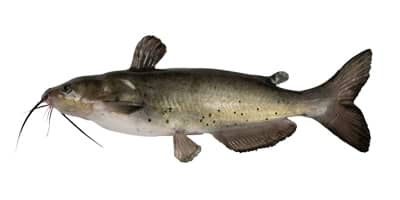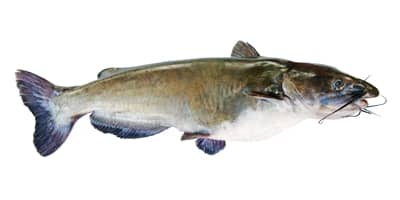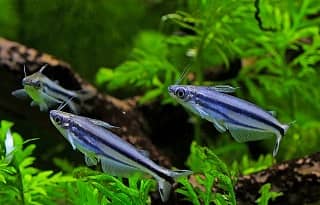As with any other being from the animal world, catfish also have various subspecies. They differ in usual size, appearance, behavior, and even taste. Before picking up your catfishing trip, it would be useful to find out something about the 11 most common types of catfish and their characteristics.
1. Blue Catfish (Ictalurus furcatus)
The blue catfish is a big fish with a greyish-blue body and barbels surrounding its mouth. It was first brought to the area in the 70s and is now regarded as an invasive species. This is a very popular species for sports fishing. In North America, it’s the most desirable species of catfish, and has a large population in many lakes and rivers. They’re opportunistic feeders, meaning they’ll eat almost anything they can get a hold of. They can be caught in both deep and shallow water, depending on the season and the time of the day.
Read More : Can we eat blue catfish ?
Identification
The easiest way to identify the blue catfish is by their greyish blue color, dorsal fin, and smaller whiskers. If you’re still unsure, count the rays on the anal fin. Blue catfish have from 30 to 36 rays, whereas channels have up to 29.
Habitat
The blue catfish prefer bigger rivers and streams and spending time in their deeper parts. They can withstand a wide range of water conditions. They’re more active during the night when they feed in faster and more shallow waters. In the daytime, they usually occupy holes and passages on the bottom.
Distribution
Blue catfish naturally inhabit the Mississippi river basin including the Ohio, Missouri, and Tennessee rivers together with the Rio Grande. They have also been artificially introduced into the various rivers and lakes in South Carolina, Florida, Maryland, and Virginia.
Size
The usual length ranges from 25 to 46 inches. The biggest specimens reached 65 inches. In terms of weight, they often reach about 35 pounds but can grow well over 100 pounds. Blue catfish is the largest catfish species in North America.
2. Channel Catfish (Ictalurus punctatus)

Channel catfish is the most common type of catfish in the US. It’s the official state fish in a total of 5 states. In recent years it’s also been introduced in many countries across Europe and Asia.
It’s also widely considered an invasive species. In the US it’s the most popular species for fishermen, second only to bass in some places. It’s partly because it can be caught using a variety of fishing techniques and types of bait.
Identification
Channel catfish usually have a greyish-green body with a white belly. Four long whiskers surround its wide mouth. Similar to channel catfish, they have a forked tail, but a shorter anal fin with 35-29 rays.
Habitat
Channel catfish inhabit mainly the bottom of both fresh and saltwater bodies. Unlike blue catfish, they are more often found in slow-moving waters such as channels or still water such as lakes or ponds.
Distribution
Channel catfish are naturally found in lower Canada, the midwest and the eastern US, and the north of Mexico. They’re pretty abundant throughout the many lakes, rivers, and reservoirs in the US.
Size
On average, the channel catfish weigh between 2 and 4 pounds. The largest ones can grow up to 40 or 50 pounds. But generally, 20-pound channels are considered a large catch.
Also Read : Can we eat Channel Catfish?
Flathead Catfish

It looks very similar to the other two main catfish types. It has no scales, it’s slick, barbels surrounding the mouth and large dorsal and anal fins. Popularly named “mudcat”, “shovelhead cat”, or the “yellow cat”. Unlike channel and blue catfish, flatheads feed primarily, on live prey available at their habitat. This means you’re most likely to catch them using similar types of live bait. Adult flatheads are typically found alone, rather than grouped like the blue catfish. Over the day they like to stay hidden in tight passages and cavities, but at night they come to shallow water to feed.
Identification
They can easily be mistaken for channel catfish, but the main thing that sets them apart is the wider, yellowish body. The head also appears to be slightly flatter than that of a channel or blue catfish, hence the name.
Habitat
Flatheads are mainly freshwater species, they can’t survive in the full salinity of the sea. But they can be found in some brackish waters. They settle in the deep parts of rivers, streams, lakes, or reservoirs. They prefer cloudy water and gentle currents.
Distribution :
This type of catfish can be found anywhere from the Great Lakes to the Gulf of Mexico. They inhabit the big rivers of Mississippi, Missouri, Ohio, and their tributaries.
Size
They can grow up to 60 inches in length and weigh as much as 125 pounds. This makes them the second largest catfish type, after the blue catfish. On average they are between 25 and 46 inches long.
Learn More : Can we eat flathead catfish?
White catfish (Ameiurus catus)
Also known as the White bullhead, is a smaller type of catfish. They usually feed on aquatic insects, worms, and smaller fish. It tastes good and has firmer flesh, which makes it a great fish for your family dinner. They’re usually caught using live baits. Baitcasting and bottom fishing are the most widely used techniques for catching white catfish. You’ll easily identify them by their unique whisker-like barbels on the chin.
Identification
It’s usually mistaken for the channel catfish due to its similar appearance and size. But they differ in some features such as shorter anal fin, bigger head and mouth, and shorter side barbels. They are generally dark gray with greenish and greyish tones and a white belly.
Habitat
They settle for muddy bottoms of rivers, streams, lakes, and larger reservoirs across the US. They prefer backwaters and places with slower currents, as well as still waters. They are more resistant to salt in the water than channel catfish.
Distribution
They are naturally found in water bodies connected with the East Coast of the US, from New York to Florida.
Size
It usually weighs from 0.5 to 2 pounds, but it can grow and weigh up to 10 pounds. The most common length ranges from 8 to 17 inches.
Cory Catfish (Corydoras genus)

This family of catfish is among the smallest ones and is usually found in aquariums around the world. They are mainly freshwater species but can’t tolerate high water salinity. Smaller insects and worms are their main sources of food. They’re not aggressive and get along with different species in the aquarium, which makes them very popular among aquarists. They can live up to 5 years or even longer if you take good care of the water parameters and the tank. They do good on their own but are recommended to be kept in pairs.
Identification
They closely resemble their bigger catfish relatives such as channel catfish. Their barbels and the shape of their body and fins also tell you which family they originate from. Color varies from light brown or green to darker patterns with spots all over.
Habitat
They’re typically found in slower streams and rivers and still waters such as ponds. The river banks are often full of plants which is an ideal place for cories. They also like to settle at the bottom in the sand, gravel, or mud.
Distribution:
They naturally inhabit streams in South America, from the Andes to the Atlantic coast, and from Trinidad to Argentina.
Size
They are small catfish subspecies, ranging from just an inch to five inches in length.
Glass Catfish (Kryptopterus vitreolus)

Also known as the “ghost” or the “phantom” catfish. It belongs to the Kryptopterus catfish genus. The name came from its see-through body. In the case of illness or death, their color turns white. They also have no scales, like the rest of the catfish species. They are also commonly traded aquarium species. They are more sensitive to water parameters than other small catfish species, so you’ll need to be careful. With the right conditions, they can live up to 8 years in your tank. But it’s important to have at least two or three since they get stressed when solitary.
Identification
You can easily identify them by their transparent scale-less body and whisker-like barbels. At right lighting, they can appear to have a pattern of rainbow colors.
Habitat
Unlike the majority of other catfish types, glass catfish prefer swimming closer to the surface. They seek cover in the vegetation of the river banks. In the aquarium, they are very sensitive to changes in water Ph. They are non-aggressive and should be kept in groups of at least 5.
Distribution
They are native to rivers and streams in Thailand and Malaysia.
Size
They are very small, with lengths ranging up to 3.1 inches. They usually grow to 2.5 inches.
Otocinclus Catfish

Also known as “dwarf sucker” or “otos”. This is another smaller catfish species commonly seen in aquariums. They are often bought because they feed on algae and help maintain your fish tank. For that reason, you mustn’t keep the tank too clean. Even in the right conditions, they live shorter than their relatives, up to 3 years. They’re great for smaller tank sizes since they rarely exceed 2 inches in length. Because of its fragile body and skin, it’s best to avoid gravel at the bottom of the tank and go for sand instead.
Identification :
This type of catfish is identified by its vertically grouped armor plates that cover their bodies. They also possess spiky fins.
Habitat
They inhabit slower streams and rivers, usually along the banks. They are mainly living close to the surface and even have the ability to breathe the air. Algae and various microbes and bacteria are their main food sources.
Often found in aquariums where they need fresh water, as they are sensitive to salt and temperature.
Distribution
They are naturally found in South America, all the way from the Andes and from northern Venezuela to Argentina.
Size
They typically grow anywhere from 1 inch to 2.5 inches.
Bristlenose Pleco
Bristlenose catfish or bushy nose catfish, as it’s also known, is a catfish from the Ancistrus genus. They are a part of the nocturnal freshwater catfish family. The name “Pleco” comes from the aquarists and can be mistaken for Hypostomus plecostomus. They’re mainly herbivores and eat mainly algae, which makes them a great addition to many fish tanks. Even though they function in larger communities, it’s best to make a separate hideout for each Pleco, as they become more territorial over time. Normal fish tank conditions are sufficient for breeding, as they are easy to breed n captivity.
Identification
Like other catfish types from this family, bristlenose pleco’s also have armor-plated bodies with suckermouth. They come in darker colors such as grey, brown or black, and often have yellow or white spots.
Habitat
Species from this family have known to be real cavefish, with their reduced pigmentation and reddish eyes. They are also bottom-dwellers, so you’ll need to take that into account when designing the tank. Adult fish can withstand the change in water conditions, which makes it easier for beginners.
Distribution
The Amazon drainage is their best know natural home, as well as tropical parts of South America.
Size
Their length often ranges from 4 to 6 inches.
Bumblebee Catfish (Microglanis iheringi)
Colorful pattern with darker and brighter stripes is very entertaining to look at, and its the reason this species got this nickname. It’s also one of the nocturnal freshwater fish species, so it rarely comes out of its hole during the day. As a pet, they are a great choice. A colorful pattern and shy personality make them always fun to watch. Being low-maintenance and resistant to many fish diseases are the reasons many beginner aquarists pick them. It’s not recommended to try breeding them in your tank, as you’ll most likely just lose time and money.
Identification
The body shape resembles other catfish types, but an easy way to tell them apart is by its unique color pattern – black and yellowish vertical stripes.
Habitat :
These catfish like to stay hidden in various holes and cavities near the bottom of smaller rivers, streams, ponds, or swamps.
Distribution
They are found in rivers, streams, and ponds across Venezuela and Columbia. Its Asian relative inhabits swamps lakes and rivers in Thailand, Malaysia, and Indonesia.
Size
It usually grows up to 5 inches, but some can reach even 8 inches.
Chinese Algae Eater (Gyrinocheilus aymonieri)

Chinese algae eater, also known as Siamese algae eater or honey sucker, is a freshwater fish. This type of fish is interesting as both aquarium fish and as food to locals. They are commonly chosen for their algae eating habits, which diminish with age. In the right settings, these catfish can even live up to 10 years. Larger tanks work better, especially with larger specimens. If you have a smaller tank, don’t put more than one of the Chinese Algae Eaters, since they can get aggressive. Home breeding is complicated since you’ll need to use hormonal injections.
Identification :
The easiest way to identify Chinese Algae eaters is by the dark stripe that goes across the body. They have blurry patterns and light brown or golden colors of the body and a white belly.
Habitat
It is usually found in large rivers and sometimes even the flooded fields. It uses its mouth to stick to rocks, and usually dwells on flat surfaces in the water. In aquariums, they prefer algae, but as they grow older tend to switch to meatier food and become more aggressive.
Distribution
This species is distributed through Southeast Asia- namely Cambodia, Laos, Thailand, and Vietnam.
Size
They usually grow to about 5 inches in length, but some are recorded to reach more than 11 inches in their natural surroundings.
Wels Catfish

Wels catfish, also known as “sheatfish”, is a large freshwater catfish found across Europe. Due to its large potential size, and large population, it’s popular species for sport fishing. They feed mostly on worms, insects, crustaceans, and smaller fish, but there are reports of them eating rats, frogs, and birds. Throughout history, there were many accounts of wels catfish attacking humans, biting their extremities, and dragging them down to the bottom. They are often caught with rod and reel, but in some parts of Europe people catch them by using bare hands. After locating it, make it bite your hand you can pull it out of the water. Since it has small and sharp lines of teeth, this isn’t recommended.
Read More: Can We Eat wels catfish?
Identification
They have a total of 6 whisker-like barbels, two long on the upper lip and four smaller ones on the lower lip. Their skin is very slimy, with no scales as the many other catfish types. Their color ranges from black to greenish or brown depending on the water pollution and clarity. An elongated anal fin that goes all the way to the tail fin, sets them apart from other species
Habitat
Wels catfish prefer slower rivers and lakes. They like to stay sheltered in holes, openings, near bridges, or dams. Interestingly, a small healthy population still lives in the Chernobyl exclusion zone.
Distribution
They are naturally distributed in drainages that lead to the Baltic, Black, and Caspian seas. Because of their popularity among sport fishermen, they have been introduced to many countries. They can now be found from the UK in the west, all the way to China in the east.
Size
Adult size wels catfish are typically in the 4ft 3in-5ft 3in range, but they can grow in the excess of 6ft 7 in ( 2 meters). The usual weight is between 30 and 45 pounds. They can weigh over 660 lbs ( 300kg) which makes them one of the largest freshwater species.
We have also covered indepth buyers guide on
Frequently Asked Questions
1.What are the “Big 3 Types” of Catfishes
The Big 3 stand for the three most common catfish types in North America. These are channel catfish, blue catfish, and flathead catfish.
2.What are the most common catfish in North America
Channel catfish are the most commonly caught catfish in North America. They are typically eating size catfish, and rarely over 30 pounds.
3. What is the best catfish to eat?
All of the Big 3 catfish types are good to eat, but it all comes to your personal preference. The channel catfish stands for the most delicious one by many fishermen. The taste depends largely on the habitat of the fish. Clear waters tend to bring tastier catfish.
See also: Is Catfish Safe to Eat?
Final Impression
The catfish family is diverse, with some of the types being of tiny aquarium sizes, and others true river monsters. Nevertheless, those were the 11 most common catfish types you should know about, whether you want to catch a good meal or get a pet fish. Whichever you prefer, we hope that this article helped you learn about these extraordinary animals.
Related Resources:
- Beginners Guide to Catfishing?
- What is the best time to catch catfish?
- Can you eat mud catfish?
- Can you use a baitcasting reel for catfish?
